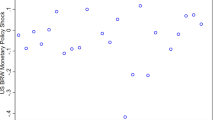Abstract
In the 1980s it became increasingly clear that the European Community market was still segmented by national borders because of non-tariff barriers to trade. A major objective of the Single Market Program in 1992 was to remove these barriers, thereby enforcing intra-union competition. In this paper, a panel of Swedish firm-level data is used to evaluate whether domestic market power has been curtailed as a consequence of the SMP and of the Swedish membership in the European Union in 1995. Evidence of increased competition emerges, as price-cost margins have declined in industries with high non-tariff barriers prior to 1992.
Similar content being viewed by others
References
Basu, Susanto and John G. Fernald (1995) “Are Apparent Productive Spillovers a Figment or a Specification Error?” Journal of Monetary Economics 36(1):165–188.
Bottasso, Anna and Alessandro Sembenelli (2001) “Market Power, Productivity and the EU Single Market Program: Evidence from a Panel of Italian Firms.” European Economic Review 45(1):167–186.
Brenton, Paul and Marc Vancauteren (2001) “The Extent of Economic Integration in Europe: Border Effects, Technical Barriers to Trade, and Home Bias in Consumption.⃑ Paper presented at the European Trade Study Group (ETSG) Third Annual Conference, 14–16 September 2001, in Brussels, Belgium.
Bresnahan, Timothy F. (1989) “Empirical Studies of Industries with Market Power.⃑ In Richard, Schmalensee and Robert Willig (eds.), Handbook of Industrial Organization Vol. 2. Amsterdam: North-Holland.
Buigues, P., F. Ilzkovitz, and J. F. Lebrun (1990) “The Impact of the Internal Market by Industrial Sector: The Challenge for Member States.” European Economy, Special Edition.
Cecchini, Paolo, Michel Catinat, and Alexis Jacquemin (1992) The Benefits of a Single Market. Aldershot: Wildwood House.
Domowitz Ian, R., Glenn Hubbard, and Bruce C. Petersen (1988) “Market Structure and Cyclical Variations in U.S. Manufacturing.” Review of Economics and Statistics 70(1):55–66.
EFTA (1992) “Effects of "1992" on Manufacturing Industries of the EFTA Countries.” EFTA Occasional Paper No. 38.
Emerson, Michael, Michel Aujean, Michel Catinat, Philippe Goybet, and Alexis Jacquemin (1988) The Economics of 1992: The E.C. Commission's Assessment of the Economic Effects of Completing the Internal Market. Oxford: Oxford University Press.
European Commission (1996a) Single Market Review. London: Konan Page.
European Commission (1996b) “Economic Evaluation of the Single Market.” European Economy, Reports and Studies.
European Commission (2001) “Price Levels and Price Dispersions in the European Union.” European Economy Supplement A. Economic trends No. 7
Feenstra, Robert C. (1995) “Estimating the Effects of Trade Policy.⃑ In Gene, M. Grossman and Kenneth Rogoff (eds.), Handbook of International Economics Vol. 3. Amsterdam: North-Holland.
Hall, Robert E. (1988) “The Relation Between Price and Marginal Cost in U.S. Industry.” Journal of Political Economy 96(5):921–947.
Hansen, Lars Peter (1982) “Large Sample Properties of Generalized Method of Moments Estimators.” Econometrica 50(4):1029–1054.
Hansson, Pär (1992) “The Discipline of Imports: The Case of Sweden.” Scandinavian Journal of Economics 94(4):589–597.
Harrison, Ann E. (1994) “Productivity, Imperfect Competition and Trade Reform: Theory and Evidence.” Journal of International Economics 36:53–73.
Helpman, Elhanan and Paul Krugman (1989) Market Structure and Foreign Trade. Cambridge MA, London England: The MIT Press.
Jacquemin, Alexis (1982) “Imperfect Market Structure and International Trade: Some Recent Research.” Kyklos 31:75–93.
Levinsohn, James (1993) “Testing the Import-as-Market-Discipline Hypothesis.” Journal of International Economics 35(1):1–22.
Official Journal of the European Communities (1990) L293 Vol. 33. 24 October 1990.
Official Journal of the European Communities (1992) L83 Vol. 36. 3 April 1992.
Smith, Alasdair and Anthony J. Venables (1988) “Completing the Internal Market in the European Community: Some Industry Simulations.” European Economic Review 32:1501–1525.
Stålhammar, Nils-Olov (1992) “Collusion and Concentration in the Swedish Manufacturing.⃑ In Yves Bourdet (ed.), Internationalization, Market Power and Consumer Welfare. London: Routledge.
Swedish Competitive Authority (2000) “Why are the Swedish Prices so High?” (in Swedish) Report Series No. 2000:2. Stockholm.
Tybout, James R. (2001) “Plant and Firm Level Evidence on “New” Trade Theories.⃑ In James Harrigan (ed.), Handbook of International Economics Vol. 3. Amsterdam: North-Holland.
Wieser, T. (1989) “Price Differentials in the European Economic Space,” European Free Trade Association Occasional Paper No. 29. EFTA Economic Affairs Department.
Winters, L. Alan (1992) Trade Flows and Trade Policy After ‘1992’. Centre for Economic Policy Research. Cambridge: Cambridge University Press.
Author information
Authors and Affiliations
Corresponding author
Additional information
JEL Classification Numbers: F15, L11, C33
Rights and permissions
About this article
Cite this article
Gullstrand, J., Johansson, H. The Disciplinary Effect of the Single Market on Swedish Firms. Open Econ Rev 16, 381–398 (2005). https://doi.org/10.1007/s11079-005-4743-3
Issue Date:
DOI: https://doi.org/10.1007/s11079-005-4743-3




